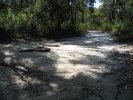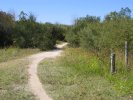You are hereThe NoBMoB Handbook / How to Identify and Grade Trails
How to Identify and Grade Trails
Difficulty Rating
IMBA have a very nice page on grades of trail difficulty. It's handy to be familiar with this when trying to describe trails or to use as a guide when deciding if a particular trail is suitable for your skill level.
A summary table is this:
|
Easiest |
Easy |
More Difficult |
Very Difficult |
Extremely Difficult |
|
|---|---|---|---|---|---|
| Trail Width | 2.1m or more | 90cm or more | 60cm or more | 30cm or more | 15cm or more |
| Tread Surface | Hardened or surfaced | Firm and stable | Mostly stable with some variability | Widely variable | Widely variable and unpredictable |
| Average Trail Grade | Less than 5% | 5% or less | 10% or less | 15% or less | 20% or more |
| Maximum Trail Grade | Max 10% | Max 15% | Max 15% or greater | Max 15% or greater | Max 15% or greater |
| Natural Obstacles and Trail Technical Features (TTFs) | None |
Unavoidable obstacles 5cm tall or less |
Unavoidable obstacles 20cm tall or less |
Unavoidable obstacles 38cm tall or less |
Unavoidable obstacles 38cm tall or greater |
|
Avoidable obstacles may be present |
Avoidable obstacles may be present |
Avoidable obstacles may be present |
Avoidable obstacles may be present |
||
|
May include loose rocks |
May include loose rocks |
||||
|
Unavoidable bridges 90cm or wider |
Unavoidable bridges 60cm or wider |
Unavoidable bridges 60cm or wider |
Unavoidable bridges 60cm or narrower |
||
|
TTF's 60cm high or less, width of deck less than 1/2 the height |
TTF's 1.2m high or less, width of deck less than 1/2 the height |
TTF's 1.2m high or greater, width of deck is unpredictable |
|||
|
Short sections may exceed criteria |
Many sections may exceed criteria |
Full page here:
http://www.imba.com/resources/trail_building/itn...
Here's a few examples of what to expect on each level of trail.
White
As this is defined as a track a vehicle could fit down it would have to be firetrail. Also note that these trails should not have any sections over 10% grade and should be smooth (eg. have no drops or roll-offs). Eg:
Green
Narrower or steeper or with some unavoidable drops of up to 5cm - equivalent of riding up or off the average kerb. Eg:
Blue
Again, narrower and steeper and with larger unavoidable drops/steps of up to 20cm. Eg:
Black
Unavoidable obstacles of up to 38cm - like riding up or off a low sofa. Eg:
Double Black
Unavoidable obstacles of over 38cm. A double black run is most likely to be incredibly steep, technical, with loose surface or all of the above. Eg:
Track Type
On our site we also talk about types of trail. Here's a quick idea of what we mean by the these:
Single Track - Enclosed
Single track is pretty obvious - a trail only wide enough to ride single file.
The enclosed type is bordered at both sides by vegetation or rocks or fences or something. This type of trail is a rider's dream! 
Both varieties of single track are also referred to as 'sniggle' (a term that allegedly originates from the MTB-OZ mailing list and a common typo for the work single).
Single Track - Open
Still too narrow to ride anything but single file, but out in the open (with nothing to crash into normally).
Double Track
Wide enough to ride side by side (and often to drive on), but not a full on fire trail or 4WD road (ie. not graded or with a centre line of grass/rocks/etc.).
Firetrail
Trail wide enough to drive a vehicle on with no centre divide. To MTB riders there's no real difference between a firetrail (built by the fire services for access and protection) and other 4WD tracks or forest roads so we classify them all under the same thing here.




























